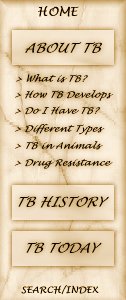|
 |
Tuberculosis in Animals
Bovine TB is the name we use to describe tuberculosis when it infects cattle, but tuberculosis can also be found in other animals; and these animals can also pass TB to humans. Tuberculosis in animals can be caused by any of a number of different bacteria, all belonging to the genus Mycobacteria: M. tuberculosis, M. avium, M. bovus, M. kansasii, and M. chelonae can all cause disease in humans. Susceptible species--or animals that can carry tuberculosis--include humans, primates, goats, cats, dogs, pigs, buffalo, badgers, possums, deer and bison.*
While transmission of TB from animals to humans used to be most commonly between cattle and people, through milk, it is now more common for humans to contract TB from animals through the airborne route. This means that people working with animals need to be careful because they are at risk of getting TB just by being in close proximity to other animals. It is still important for farmers in Canada to ensure that their cattle herds are kept clean of TB, because cows can come into contact with infected wildlife and become infected themselves.
* from "The epidemiology of Mycobacterium bovis infections in animals and man: a review" in Tubercle and Lung DieaseDisease, 1995, vol. 76 suppl. 1, pages 1-46.
|


